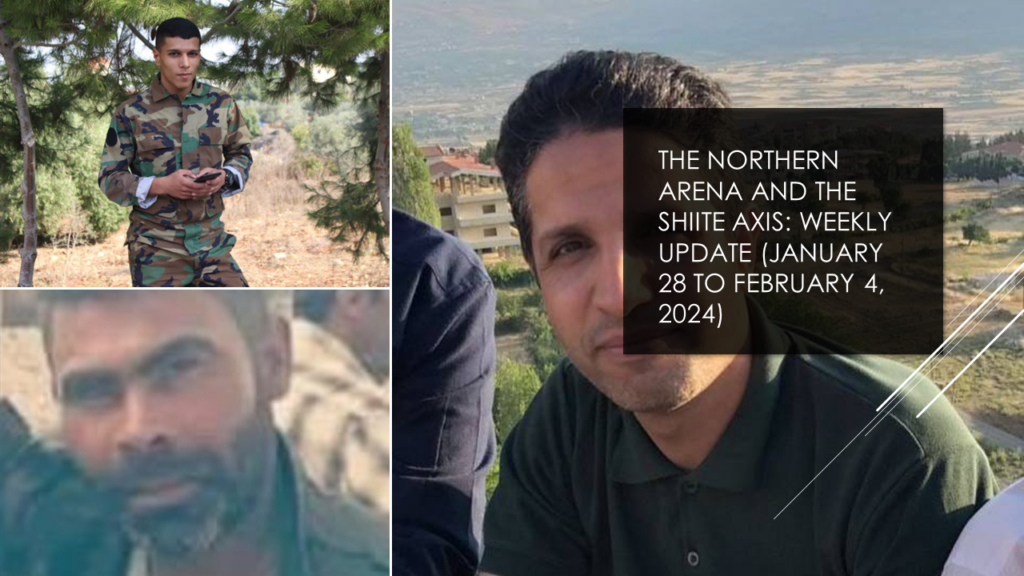Main points:
- 47 shooting incidents for which Hezbollah claimed responsibility this week.
- Hezbollah used Falk rockets and Almas anti-tank missiles for the first time.
- The identity of the terrorist who carried out the attack at the Megiddo junction (March 2023) was revealed.
- Following an attack on an American base in Jordan and the killing of three US soldiers, a large American attack was carried out on Axis targets on the Iraq/Syria border on February 2, killing and wounding militiamen, including a senior operative (militia commander?) belonging to the Fatemiyoun militia.
- Airstrikes in the Aqraba area in southern Damascus killed, among others, a “consultant” belonging to the Quds Force (February 2).
- Houthi-land – The Arrow system intercepted a ballistic missile launched at Israel (February 2).
- Extensive attacks on targets by the coalition (February 4).
Insights/Key Points:
Hezbollah has no real intention of withdrawing from the border, and Lebanese governmental authorities do not influence Hezbollah. An agreement will not separate the military infrastructure, which is interwoven with the civilian infrastructure.
Hezbollah operatives have not departed the border area because the majority of them live and work in the villages south of the Litani River, near the border.
So far, the IDF’s attacks against Hezbollah have not significantly harmed the organization’s operational capabilities. Hezbollah’s primary systems, including the rocket and anti-tank fire system, the air unit, the Radwan unit, and the strategic missile array, are prepared for action.
The vast majority of the Shiite base is Hezbollah’s captive audience (for religious, ideological, fear, and dependency reasons). Hezbollah does not regard the rest of the Lebanese populace (Christians, Sunnis, Druze, Palestinians) while determining whether to escalate its conflict with Israel.
Iran is attempting to differentiate itself from the proxy’s actions, however, simply identifying the weaponry used by the proxy reveals who is the single force builder and director behind the scenes: Iran’s anti-aircraft missiles, UAVs, anti-ship missiles, anti-tank missiles, rockets, sniper rifles, and more.
The Lebanese arena:
War data:
Israel’s government evacuated 43 communities up to five kilometers from the Lebanon border. A total of approximately 61,000 citizens. An additional 20,000 people had independently decided to leave their homes.
It should be noted that not all Israeli communities have been totally evacuated, and there is still a civilian presence. Hezbollah attacks the communities using mortars, rockets, and anti-tank missiles, as well as drones and UAVs. Hezbollah has destroyed civilian dwellings and infrastructure and has killed six Israeli citizens thus far. Unlike the IDF, which targets Hezbollah-controlled buildings and infrastructure in the center of villages (human shields), Hezbollah intentionally targets civilian structures within communities.
According to Israeli Ministry of Defense publications up to February 1, Hezbollah attacks damaged 512 buildings in northern Israel, including 131 in Metula, 130 in Shlomi, 121 in Manara, 43 in Kiryat Shmona, 37 in Shtula, 25 in Zarit, 11 in Avivim, 9 in Malkiyya, and 5 in Hanita.
During the past week, Hezbollah claimed responsibility for 47 rocket attacks on Israeli territory, using sniper fire, anti-tank missiles, Burkan, Falk, and Al-Mas rockets.
Hezbollah has recently launched anti-tank rockets and mortar attacks on civilian targets in Metula, Manara, Zar’it, Matat, and Avivim.
Over the last week, 14 Hezbollah and two Amal operatives have been killed, according to reports. As of October 8, 2023, 179 Hezbollah operatives had been killed. The majority of the operatives killed were from south of the Litani River (113 operatives, or 62% of all those killed). Many Hezbollah operatives and their families live in southern Lebanon, close to the Israeli border. They operate in southern Lebanon as part of Hezbollah’s geographic and defined units, blending in with the civilian population (human shield tactics).
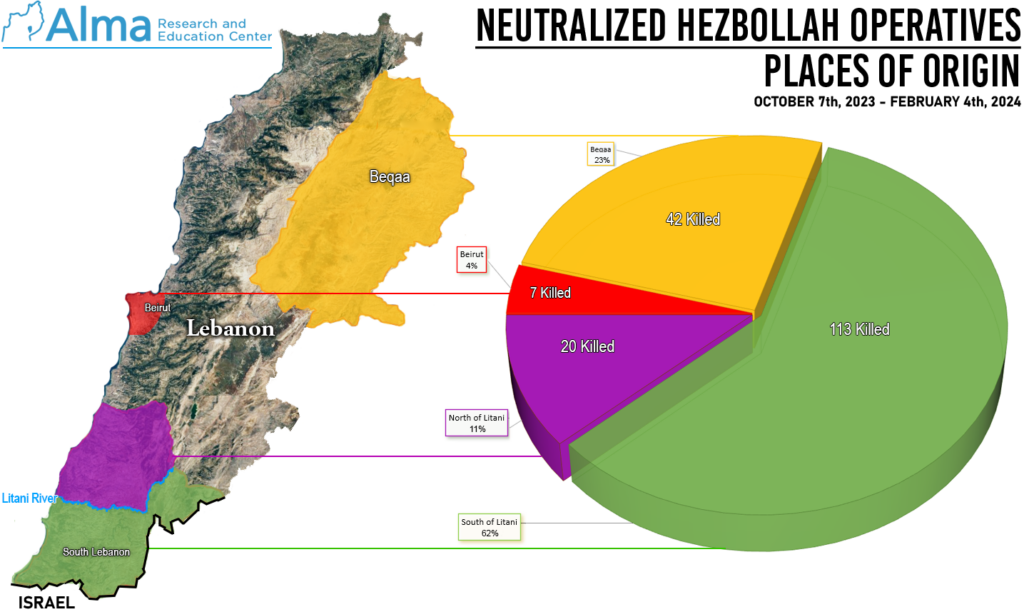
New weapons used by Hezbollah:
This past week, Hezbollah began using two new types of weapons that it had not previously used:
The Falk-1 rocket is a short-range (up to 10 km) rocket launched from vehicles. Diameter: 240 mm. The warhead weighs 50 kg.
The Almas anti-tank missile appears to be an Iranian replica of Israel’s Spike missile. The “fire and forget” strategy provides a range of up to 10 kilometers. The ballistic movement toward the target (struck from above) is not necessarily vertical. A camera that beams backward while flying.
It should be recalled that on January 24, Hezbollah launched two phosphorus-containing mortar bombs into a populated urban area in Metula. Needless to mention, phosphorus is a restricted material in inhabited regions.

Hezbollah – General:
(January 28) Hezbollah ceremonies marking Imam Ali’s birthday throughout Lebanon.
(January 30) Naim Qassem meets with independent Christian figures on the current conflict. Also present at the meeting was Hezbollah’s Christian portfolio coordinator, Mohammad Sa’id al-Nakhsa.
(February 1) The photo and name of the Palestinian terrorist who carried out the attack in Megiddo by infiltrating into Israel, riding an electric bicycle to Megiddo, and planting an IED that wounded an Israeli civilian were revealed.
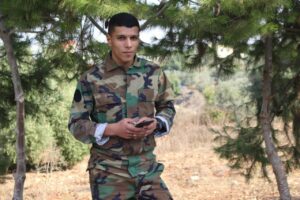
(February 2) Hezbollah holds a ceremony honoring “members of the media on the way to Jerusalem.” The ceremony was attended and sponsored by the Minister of Information in the Lebanese government. Our well-known “friend”, Ali Shoeib, Hezbollah’s mouthpiece and Al-Manar correspondent in southern Lebanon, attended and was lauded.
Lebanon – General:
There has been an increase in theft and vandalism against churches, especially in Beirut and Mount Lebanon.
A protest was held in the Shatila Palestinian refugee camp in Beirut against the cessation of funding to UNRWA on January 29.
The city of Bar Elias (the Zahleh district in the Bekaa Valley, with 60,000 Lebanese people, the majority of whom are Sunnis) “won” the title of Syrian refugee capital, given that 130,000 refugees live there and nearby (twice the local population).
The Syrian Arena:
(January 28) The Syrian Army killed eight ISIS operatives in the northern neighborhood of the town of Nawa.
(January 28) Shiite militias attacked American forces in Al-Shadadi and Rukban with UAVs.
(January 29) Airstrike against targets in southern Damascus:
As far as we know, two targets were attacked in southern Damascus, between Sayyida Zaynab and Aqraba (hit 1+2 in the photo). One target is a large, two-story villa with an adjacent swimming pool. Such a villa can be used either as a headquarters or as a place where senior officials live. The area where the villa was attacked is a well-known area that the Iranians (IRGC) and Hezbollah usually use for housing or lodging. Buildings have been attacked in this area before. The nature of the second target (if there was one) is unknown. Local reports say that several Lebanese Hezbollah operatives and three Syrian operatives were killed, all of whom were identified as Hezbollah collaborators in public pronouncements. Two of the Syrians come from villages in northern Syria north of Idlib (Kafraya and Fu’ah). These are Shiite villages, whose residents are known to support the Shiite axis in Syria. It is not known whether official Iranian announcements about the deaths of “advisors” have been published, and at this stage, it is not possible to link announcements about the deaths of Hezbollah operatives to this attack.
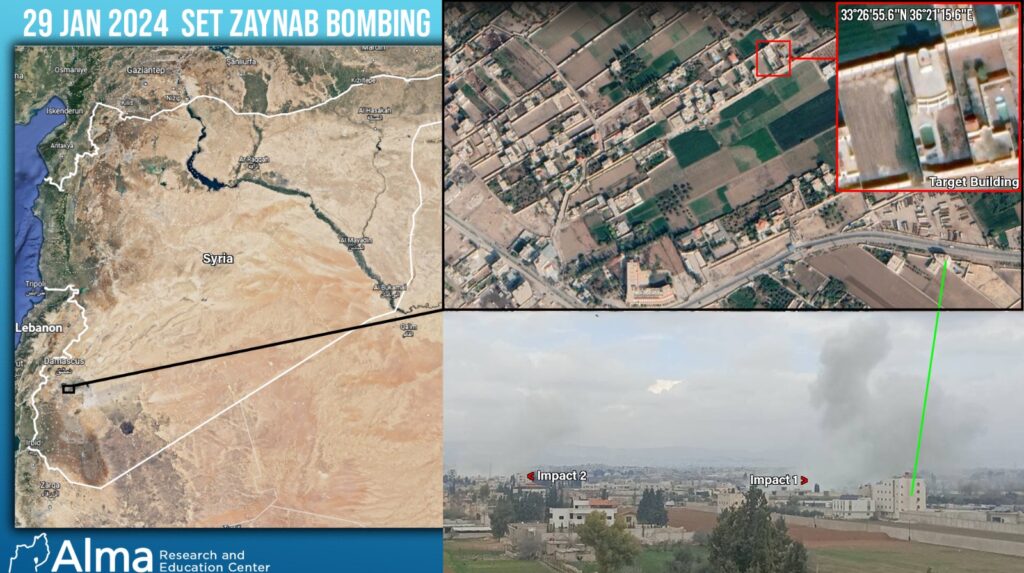
(January 30) Three rockets were fired from Syrian territory into Israeli territory. The rockets fell in open areas.
(February 2) Another attack occurred in southern Damascus in the agricultural area, where farms and villas are located in the Aqraba area, east of Sayyida Zaynab and west of the highway leading to Damascus International Airport. An IRGC member named Saeed Alidadi was killed in the attack. Apparently, two other “Iranian advisers” were killed alongside him. Ismail Qaani, the commander of the Quds Force, attended his funeral in Iran.

There are conflicting reports about Iranian “advisers” leaving Syria following the recent airstrikes.
The Shiite Axis General:
On January 28, a suicide UAV attacked the US Tower 22 base in northeastern Jordan (al-Tanf region), killing three American soldiers and wounding dozens. The suicide UAV (apparently a Shahed type) was launched by operatives of an Iraqi Shiite militia operating under direct Iranian sponsorship and guidance. This is the 165th strike against U.S. forces in Iraq and Syria since October 2023.
An accusing finger was pointed at the Shiite militia, the Iraqi Hezbollah Brigades. On January 30, the militia announced that they were freezing their activity against the US forces so as not to embarrass the Iraqi government… The announcement also stated that the Iranians were not aware of the militia’s activity, and many in the Shiite axis even opposed the activity against the US…
It is not difficult to understand that there is information warfare here and an Iranian attempt to differentiate themselves from the incident and undermine their connection and responsibility for it.
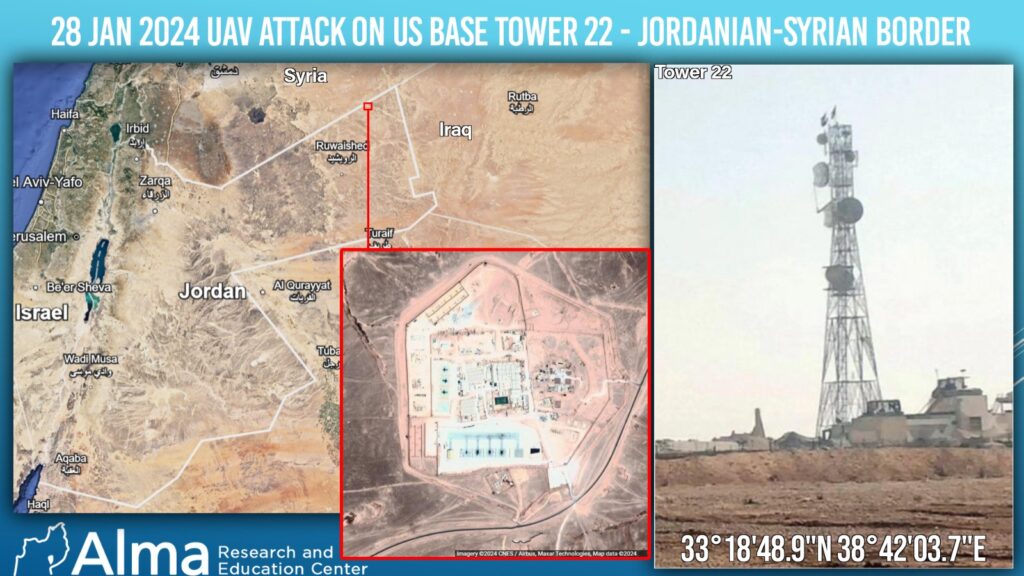
(January 28 + February 1) – Shiite militias announced that they had launched UAVs toward the port of Haifa. It is unclear what happened to these UAVs if they were launched at all. As for the February 1 UAV, there are unverified indications that it was intercepted over Syria.
(February 2) – US response to the attack on the Tower 22 base: According to the Americans, 85 targets linked to the IRGC and Shiite militias in Syria and Iraq were attacked (as far as we know, the attack was focused in the area of Al-Qaim-Albukamal-al-Mayadeen-Deir Azor). Headquarters and war rooms, intelligence centers, rocket/missile/UAV depots, and logistics/supply facilities were also targeted. According to other sources, Jordanians were also involved in the attack.
Militia operatives were killed and wounded in the attack. It is possible that one of the senior operatives (commander?) of the Fatemiyoun militia, Ali Husseini, was killed.

As of February 4, infrastructures (electricity, for example) are already being rehabilitated in the affected areas.
(February 2) – Iraq’s prime minister declared three days of public mourning “in honor of the souls of the martyrs killed by the American bombings…”
(February 3) – In response to the American airstrike, Shiite militias attacked four American bases in northeastern and southeastern Syria and two bases in northern Iraq.
Houthi-Land:
During the past week, coalition forces managed to strike 16 UAVs, 2 explosive boats, and 10 missiles launched or intended to be launched by the Houthis against ships in the Red Sea/Bab el-Mandeb.
(February 2) – The Arrow array intercepted a ballistic missile launched by the Houthis at Israel.
(February 4) – Coalition forces carried out airstrikes against 13 targets in Houthi-land: underground weapons depots, war rooms, missile storage sites, UAVs, and helicopters were destroyed in the attacks.

